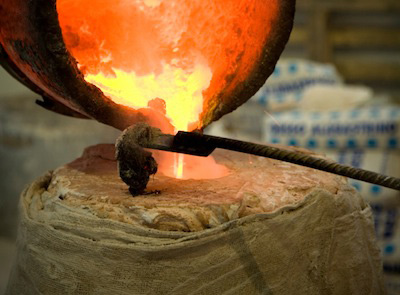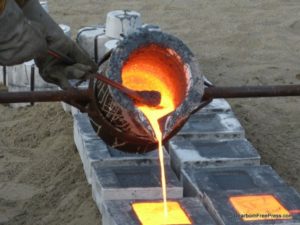A guide into Aluminum Foundry techniques and casting advantages
Understanding the Steel Castings Refine: A Comprehensive Overview for Beginners
The Metal Casting procedure is a fundamental strategy in manufacturing that changes molten metal into strong types. Newbies must comprehend the different approaches entailed, such as sand casting and pass away casting. Comprehending the materials, design principles, and safety steps is similarly essential. Each facet plays a crucial role in accomplishing effective end results. As one navigates these complexities, the inquiry of exactly how to enhance each step for enhanced results becomes significantly important.
The Basics of Steel Casting
Although Metal Casting has actually progressed over centuries, its fundamental concepts stay integral and regular to the manufacturing process. At its core, Metal Casting includes the makeover of molten steel right into solid things through numerous methods. The process starts with the development of a mold and mildew, which defines the form of the end product. Once the mold and mildew is prepared, metal is heated to its melting point and poured into the cavity. After cooling, the metal solidifies, taking the shape of the mold.
There are numerous casting approaches, consisting of sand casting, investment spreading, and die casting, each with special advantages and applications. The selection of method depends upon variables such as production quantity, material kind, and wanted precision. Once cast, the last item might undergo extra procedures like machining or surface treatment to accomplish the called for surface and specs. Comprehending these fundamentals is important for anyone thinking about the area of Metal Casting.

Understanding Products Made Use Of in Metal Casting
Materials play an important duty in the Metal Casting procedure, affecting the final item's residential or commercial properties and performance. Various steels are used, consisting of light weight aluminum, iron, steel, and bronze, each offering unique qualities suited for specific applications. Light weight aluminum is light-weight and corrosion-resistant, making it optimal for automotive parts. Iron, particularly cast iron, is preferred for its superb wear resistance and toughness. Steel offers high strength and convenience, typically used in heavy machinery elements. Bronze, known for its deterioration resistance and machinability, is frequently used in aquatic applications.
Along with the steels, numerous casting materials, such as sand, plaster, and ceramic, are made use of to produce mold and mildews. Sand spreading, one of the most widespread approach, makes use of silica sand as a result of its thermal stability and capacity to develop complex forms. Plaster and ceramic mold and mildews supply finer details however might call for even more complex procedures. The selection of products straight impacts the performance, price, and high quality of the casting procedure.
The Design Process: From Concept to Plan
The design procedure in Metal Casting begins with the preliminary idea advancement, where ideas are created and reviewed. This is complied with by the application of CAD modeling techniques, enabling specific visualizations of the style. The blueprint completion steps guarantee that all requirements are precisely documented for production.
Initial Principle Growth
First principle growth notes an essential stage in the Metal Casting procedure, where concepts change into tangible designs. Throughout this phase, developers collaborate with stakeholders and engineers to brainstorm and improve preliminary ideas. They consider variables such as capability, aesthetic appeals, and manufacturability, making certain that the style satisfies the needed specifications and efficiency criteria. Sketches and outlines are developed to picture the concepts, enabling preliminary assessments of usefulness and cost-effectiveness. This phase likewise includes recognizing products and potential casting techniques that align with the style objectives. Ultimately, preliminary principle development lays the foundation for a thorough blueprint, assisting the succeeding phases of the spreading procedure and ensuring a successful shift from concept to fact.
CAD Modeling Techniques
Changing concepts into accurate layouts, CAD modeling methods play an essential function in the Metal Casting procedure. These techniques use advanced software application to produce in-depth three-dimensional designs that precisely mirror the desired product. By employing tools such as parametric modeling, strong modeling, and surface area modeling, designers can adjust dimensions and forms effortlessly. CAD systems also assist in simulation and analysis, permitting the recognition of potential problems before manufacturing starts. This aggressive strategy minimizes material waste and enhances the layout for manufacturability. In addition, CAD designs can be quickly customized, allowing quick iterations based on feedback. Basically, CAD modeling works as the foundation of the style process, linking the space between initial ideas and the ultimate production-ready layouts.
Blueprint Finalization Steps
Complying with the development of comprehensive CAD models, the next phase includes blueprint finalization, which is important in equating digital designs into workable strategies for production. This procedure starts with reviewing the CAD designs for accuracy and compliance with specifications. When confirmed, the dimensions, tolerances, and product specs are carefully outlined to assure clarity. Incorporating notes and comments assists connect vital details concerning casting procedures, surface area finishes, and assembly requirements. The completed plan undergoes a strenuous approval procedure, often including collaboration with designers and production teams to attend to any kind of prospective concerns. After all modifications are made and authorizations acquired, the blueprint is officially released, acting as the fundamental document for the subsequent phases of Metal Casting, consisting of pattern production and mold and mildew layout.
The Steel Casting Methods Discussed

Metal Casting techniques incorporate a range of methods made use of to shape liquified steel right into preferred kinds. These techniques differ according to the type of material, complexity of the layout, and production volume. Sand casting is among one of the most common approaches, including the production of a mold from sand to hold the molten steel. Investment spreading, or lost-wax casting, enables elaborate layouts by utilizing a wax click now pattern that is dissolved. Pass away casting employs high-pressure shot of molten steel into a mold, ideal for mass manufacturing. Other approaches include permanent mold and mildew casting, which makes use of reusable molds, and centrifugal casting, where rotational pressures assist in filling up the mold. Each method has its benefits and applications, making it important for suppliers to choose the suitable technique based upon their details requirements and requirements. Recognizing these methods is necessary for any person associated with the Metal Casting process.
Completing Procedures: Enhancing Your Casted Item

Ending up processes play an essential role in boosting the top quality and appearance of casted items. Numerous surface therapy strategies, such as polishing and covering, are used to improve sturdiness and aesthetic appeals. Additionally, quality inspection methods ensure that the end product fulfills specified criteria and efficiency demands.
Surface Area Treatment Techniques
A selection of surface therapy techniques play an essential role in enhancing the quality and longevity of casted items. These strategies include approaches such as shot blasting, brightening, and covering. Shot blasting properly eliminates surface area blemishes, enhancing the useful and visual attributes of the casting. Polishing provides a smooth surface, which is particularly essential for attractive applications and elements requiring minimal friction. Finishing methods, such as electroplating or powder coating, offer extra security against rust and wear, making certain sturdiness. In addition, surface area therapies can boost adhesion for succeeding processes, such as painting or bonding. By utilizing these methods, manufacturers can accomplish premium surface area quality, which is vital for the performance and life-span of Metal Casting in numerous applications.
Top Quality Examination Approaches
Reliable top quality evaluation methods are vital for ensuring the stability and performance of casted items after the ending up procedures. Different methods are used to examine the high quality of Metal Casting, including aesthetic evaluation, dimensional checks, and non-destructive screening (NDT) Aesthetic examination permits the identification of surface problems, while dimensional checks assure that products fulfill defined resistances. NDT methods, such as ultrasonic screening and radiographic inspection, provide much deeper insights into interior honesty without damaging the spreadings. Additionally, mechanical testing, such as tensile and solidity examinations, assesses material buildings - Aluminum Foundry. By using a mix of these methods, suppliers can enhance item quality and dependability, ultimately causing better client satisfaction and lowered production expenses
Safety Considerations in Metal Casting
While the Metal Casting procedure offers various advantages, it likewise presents a series of safety threats that should be very carefully managed. Workers in casting centers are exposed to heats, molten steels, and hazardous materials, which can result in extreme injuries if proper safety measures are not taken. Personal protective tools (PPE) such as heat-resistant handwear covers, face shields, and his explanation safety apparel is important to decrease dangers.
Furthermore, the existence of fumes and dirt demands correct ventilation systems to guarantee air high quality - Wisconsin Aluminum Foundry. Routine training on safety methods is essential for all employees to acknowledge potential threats and respond effectively. Emergency procedures ought to be established, including fire safety procedures More hints and very first aid accessibility. Maintenance of tools and appropriate handling of products additionally add to a much safer working atmosphere. By focusing on these safety and security factors to consider, Metal Casting procedures can safeguard their workforce and maintain efficient production processes
Often Asked Concerns
What Are the Environmental Influences of Metal Casting?
Metal Casting can lead to environmental effects such as air and water contamination, source depletion, and energy usage. Furthermore, incorrect waste administration and emissions from foundries add to environmental disturbances and wellness dangers for close-by neighborhoods.
Exactly how Do I Choose the Right Metal for Spreading?
To pick the appropriate metal for spreading, one have to take into consideration aspects such as mechanical residential or commercial properties, corrosion resistance, thermal conductivity, and expense. Reviewing the intended application and environmental problems is necessary for ideal selection.
What Are the Typical Flaws in Metal Casting?
Typical issues in Metal Casting include porosity, shrinking, sand inclusion, and misruns. These concerns typically emerge from incorrect material choice, insufficient layout, or problems in the casting procedure, impacting the end product's quality and performance.
How Can I Boost My Metal Casting Skills?
To boost Metal Casting skills, one should practice continually, study casting strategies, assess previous jobs for problems, seek responses from knowledgeable wheels, and continually trying out various products and techniques to enhance efficiency and understanding.
What Is the Cost of Beginning a Metal Casting Company?
Starting a metal casting business typically requires an initial investment of $5,000 to $50,000, depending upon equipment, products, and facility prices. Aspects like location and range can considerably affect overall startup expenditures.
The Metal Casting procedure is an essential technique in manufacturing that transforms molten metal into solid kinds. Novices need to grasp the numerous methods entailed, such as sand casting and die spreading. There are a number of casting techniques, including sand casting, investment casting, and die spreading, each with special advantages and applications. Investment casting, or lost-wax casting, permits for detailed designs by utilizing a wax pattern that is thawed away. Other approaches include irreversible mold and mildew spreading, which makes use of recyclable molds, and centrifugal casting, where rotational pressures aid in loading the mold.